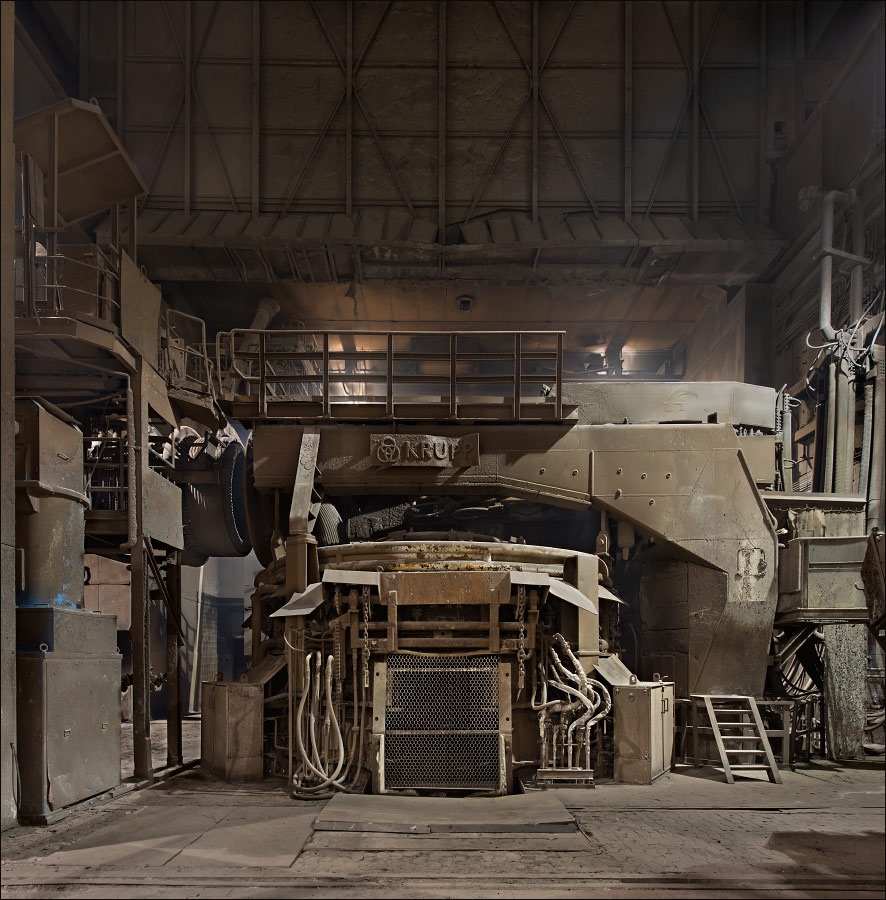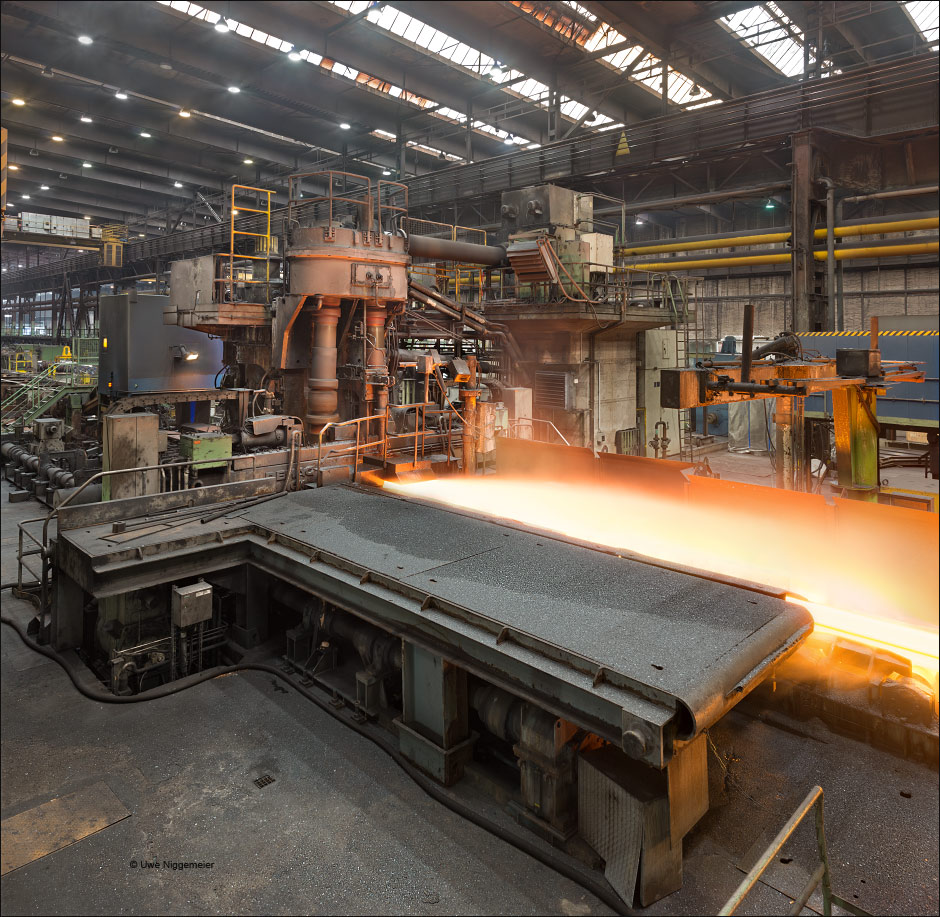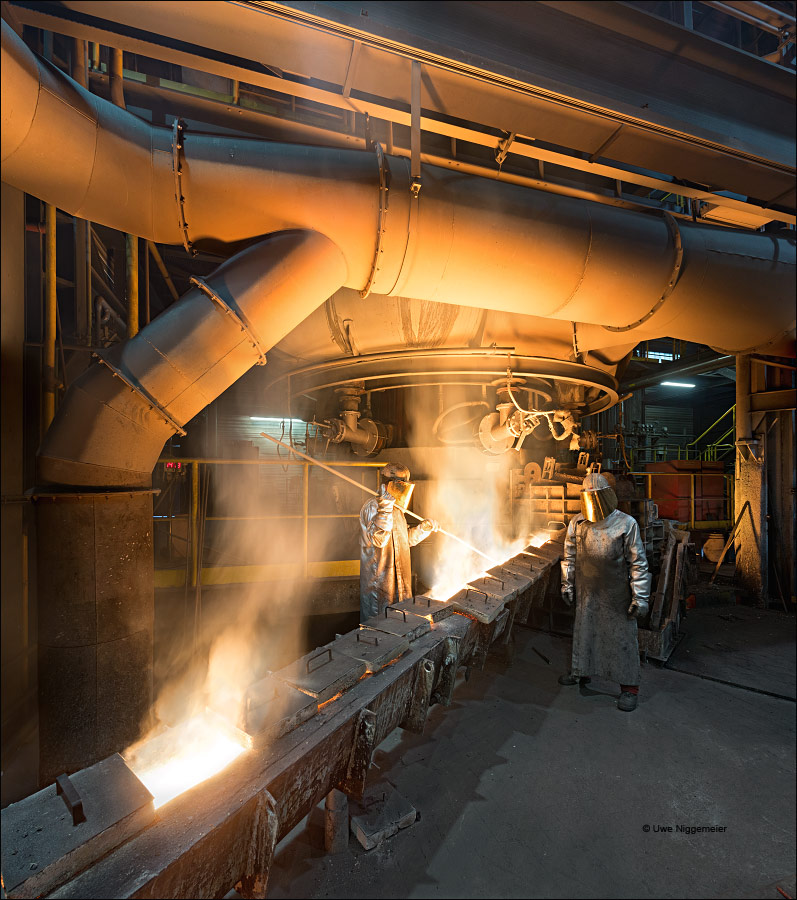Innenansichten.
Schwerindustrie International.
Fotografien von Uwe Niggemeier.
Ausstellung im Hoesch-Museum, Dortmund.


A history of more than 170 years of steel making ended in Bochum, Germany in late June when the Nirosta stainless steel plant was closed for good.
The original BOF shop was built in 1957 by the Bochumer Verein to be only the second of it’s kind in Germany.
In 1972, after the closure of the blast furnace site both vessels were transformed into AOD converters and an electric arc furnace was installed in the same building to produce stainless steel.
In 1982 a huge new 135 MVA electric arc melt shop was attached and the old EAF was replaced by a ladle furnace.
I payed the site a final visit before the demolition started.
installed motor capacity makes the ThyssenKrupp hot strip mill in Bochum the most powerful rolling mill in Germany. Though the mill was already planned in the early 1960ies by the Bochumer Verein steel corporation it wasn’t until 1966, after the takeover by the Fried. Krupp company, that the mill was put into operation.
The mill is capable of rolling even high alloyed speciality steel.
After the closure of the adjacent Nirosta steel mill all primary material now comes from the August Thyssen Hütte in Duisburg.
Images now at stahlseite.

After more than 10 years I visited my hometown’s unique narrow strip mill again.
Images now at Stahlseite.
The rolling mill in Hohenlimburg, now part of the city of Hagen/Germany, was founded in 1846 and goes back to the old Böing forge, a descendant of this family later founded the Boing aircraft company in Seattle, USA.
The mill produced wire and later hot strip.
In 1907 the site was taken over by the Hoesch steel company from Dortmund.
In the 20th century numerous cold rolling , wire drawing and steel spring manufacturers were taken over.
In 1955 the new narrow strip mill started it’s production.The Hohenlimburg site was fusioned with Schwerter Profileisenwalzwerke AG in 1969. This rolling mill was sold to the Italian Calvi group in 2005.
The Hohenlimburg plant is now part of ThyssenKrupp Steel.

The Walter Hundhausen foundry was established in 1914 in Gevelsberg, Germany.
After WWI the company moved 25 km to Schwerte at the eastern edge of the Ruhr area.
In 1928 the production of black heart malleable castings started.
Heavy truck axle components became a main product after WWII.
Walter Hundhausen was taken over by the Hoesch steel company from Dortmund in 1989 and became part of Krupp Hoesch Automotive four years later. 1993 closure of the branch plant in Werdohl.
In 2000 the Walter Hundhausen iron foundry was taken over by the GMH group from Georgsmarienhütte.
A new large 40t/h cupola furnace replaced the old induction furnaces in 2008. The foundry employes more than 600 people.
Further images at Stahlseite.
These days the last remains (coking coal tower, dry quenching facilities) of the coking plant Kaiserstuhl in Dortmund, Germany are knocked down.
The plant was built in 1992 to be the most modern coke making facility in Europe.
It supplied coke to the nearby Hoesch blast furnaces. The plant inluded two coke oven batteries of 60 furnaces each, and both a dry and a wet quenching facility.
When ThyssenKrupp announced the closure of it’s (former Hoesch) blast furnaces Kaiserstuhl was shut down after being in operation for just eigth years .
Ten years ago most of the mill was dismantled and rebuilt in the Shandong province, China.
This relocation was documented in the exiting movie Losers And Winners.
Further images of this plant at Stahlseite.
In between 1954 and 1962 the Hoesch company in Dortmund, Germany built it’s third open hearth melt shop (SM-Stahlwerk III).
Two 180 ton furnaces were installed by 1956, two DEMAG 210 ton furnaces were added in 1961 and 1962. These might have been the last to be commissioned in West Germany.
Monthly output was less than 100000 tons, not enough to compete with the new BOF shop in Dortmund Hörde built in 1963 producing more than 300000 t/m.
The open hearth shop 3 was closed in 1982.
Some images of it’s remains: Stahlseite.
My hometown Hagen once was one of the major steel producing communities in Germany.
Blast furnaces,open hearth shops and numerous foundries shaped the confined townscape in the narrow valleys of the Volme and Ennepe rivers.
The largest steel mill, the Hasper Hütte owned by the Klöckner company, was closed in 1972 and the huge Wittmann steel foundry next to it just one year later.
The last major steel producer in town, the open hearth shop of Stahlwerke Südwestfalen was shut down in 1976, smaller ones like the Remy speciality steel mill followed in the 1990ies.
The Eisenwerk Geweke was founded in 1910 and is specialized in steel fittings.
A five ton electric arc furnace and a small induction furnace are producing castings up to four tons a piece.
Further viewing at Stahlseite.
1: Hochofen IV. 1972-1999.
2: Hochofen VI. 1965-1976
3: Hochofen VII(alt) 1962-1976
4: Roheisenmischer
5: SM-Stahlwerk 2. 1912-1980
6: SM-Stahlwerk 3. 1956-1982
7: Thomasstahlwerk. 1928-1967
8: Elektrostahlwerk. 1955-1985
9: Blockwalzwerk. 1900-1983
10: Fertigstrasse (Schwere Profile). 1900-1968
11: Walzwerk III (Halbzeug). 1888-1966
12: Walzwerke IV/V. -1966
13: Kontinuierliche Halbzeugstrasse. 1955-1983
14: Walzwerk VIII. (Feinstahl). -1957
15: Feineisenstrasse. 1957-1983
16: Warmbreitbandstrasse. 1958-2001
17: Kaltwalzwerk
18: Drahtverfeinerung
19: Schwellenschweisserei
20: Lehrwerkstatt
21: Feuerfest- Steinfabrik
22: Gaszentrale
23: Sauerstoffanlage
24: Walzendreherei
25: Sinterbänder 1/2
26: Sinterband 3. 1961-
27: Zementfabrik
28: Lok-Werkstatt
Some images at Stahlseite.de .